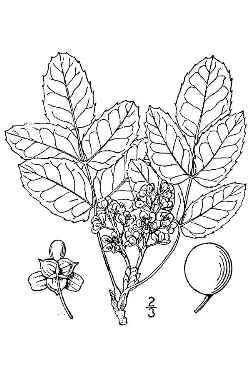Hollyleaved Barberry, Oregon Grape
Scientific Name: Mahonia aquifolium (Pursh) Nutt.
Synonym: Berberis aquifolium, Berberis piperiana, Mahonia piperiana, Odostemon aquifolium
Family: Berberidaceae

Odostemon aquifolium, Britton, N.L., and A. Brown. 1913. Illustrated flora of the northern states and Canada. Vol. 2: 128.
Sunset®: 1-21
USDA: 5-9
Sun Exposure: Light shade to shade, tolerates full sun in cooler part of the range
Origin: N. Calif. to B.C..
Growth Habits: Evergreen shrub, up to 6 feet tall (1.8 m); spreading by underground stems, forming clumps; coarse, spiny, bluish green leaves, 6 to 12 inches long (15-30 cm); 5 to 9 leaflets each 2 to 3 inches long (5-7 cm)
Watering Needs: Best with regular water, prefers acidic soils, foliage tends to be chlorotic on alkaline soil
Propagation: Division, cuttings
Propagation: Seed or occasionally cutting
- by semi-hardwood stem tip cuttings, in late autumn. Apply IBA TALC 8000 PPM. Use intermittent mist. Root in 7-8 weeks.
- by seeds, in spring. The seeds can be harvested in late summer. The seeds need cold-warm-cold stratification.
The root of mahonia is traditionally used for a variety of skin conditions, inflammations, and infections.
The genus Mahonia is named after Bernard McMahon, an American horticulturist of the 18th-19th century.
'Compactum' is a compact and slower-growing form, growing to 3 feet tall (90 cm).
Blooming Habits:
Bright yellow flowers, in dense clusters, in early spring
Fruiting Habits:
Small, bright blue, edible berries on dark red stems, ripening in summer to late summers. The birds love them. They are not generally eaten raw, but they can be used to make excellent jellies.
Desert-Tropicals is dedicated to provide gardening advice, gardening ideas, and information about flower of all kind for landscape and collections.We try to check carefully the identification of the plants on the illustrations as well as the other information from the page, but occasionally errors do occur. if you notice anything that needs to be changed please contact us.Thanks.
© 1998-2020 Philippe Faucon, All Rights Reserved.